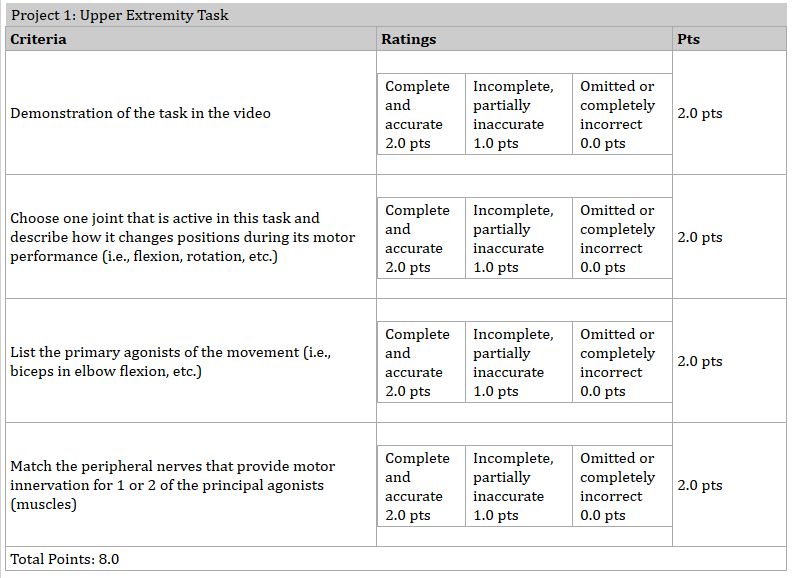About the Presenters
Kate Schultz, MS
Kate Schultz is the Assistant Director for the Master of Science in Speech, Language, and Learning and Doctor of Speech-Language Pathology programs in the School of Communication at Northwestern University. Additionally, she is an adjunct lecturer in the School of Professional Studies (SPS). She teaches two pre-health seminar courses for post-baccalaureate students, and she has been a teaching assistant for the on-campus and online anatomy courses in SPS since 2013. She has a Bachelor of Arts in Communication and Master of Science in Higher Education Administration and Policy from Northwestern University and is currently pursuing her PhD in Health Sciences with a focus on health professions education, instructional design, and assessment at Northern Illinois University.
Roberto Lopez-Rosado, DPT, MSPT, MA
Roberto earned his Bachelors degree in Biology from the University of Puerto Rico in 1993 and a Masters degree in Anatomy in 1997 from the Universidad Central del Caribe, in his native Puerto Rico. He earned his Doctorate in Physical Therapy from The Sage Colleges, New York. Currently, he teaches anatomy and clinical sciences for Northwestern University’s DPT Program, the School of Professional Studies, and Northwestern University Prosthetics and Orthotics Center. He also conducts with clinical research focusing on balance strategies and fall prevention in stroke survivors. Roberto has worked as a clinician in the outpatient setting, as well as acute care and home health. He is a member of the American Association of Anatomists, the American Physical Therapy Association and the Co-Chair of the Neurologic Physical Therapy Academy Online Education Committee.
Jessica Mansbach, PhD
Dr. Jessica Mansbach is currently a Learning Designer at Northwestern University’s School of Professional Studies. In this role, she partners with faculty throughout the School to design online courses. Jessica also teaches online courses for the School’s Information Design Strategy masters program. She has also taught for Northwestern University’s School of Education’s School of Education and Social Policy’s Higher Education Administration and Policy program She holds a doctorate degree in Higher, Adult, and Lifelong Education from Michigan State University. Before joining the School of Professional Studies, Jessica coordinated a teaching apprenticeship for College of Education graduate students at Michigan State University.
Introduction
As an alternative to an oral exam, students in an undergraduate online human anatomy class created multimedia submissions to synthesize their knowledge of musculoskeletal anatomy and innervation and apply this knowledge to a functional activity of daily living. This assignment provided a unique opportunity for creativity and diversified assessment strategies in a course that normally uses more traditional teaching and learning methods (e.g., lectures, exams, research papers). This assignment allowed students to practice using appropriate medical and anatomical terminology and simulates a potential clinical scenario they may encounter in multiple health care settings (e.g, demonstrate how movement occurs to a patient.) By selecting their own topics, students investigated movements that were relevant to their interests/hobbies.
Learning Objectives
Viewers will be able to
- recognize how to adapt an example of a multimedia assignment for use in their own classes
- describe how to use peer review to incorporate peer interaction into a basic science class
- explain the importance of creating assignments that are relevant to students’ interests and allow them to demonstrate practical skills
- give examples of how to diversify assignments in a course that typically uses lecture and exams to assess learning
- give examples of how to use assignments to engage students in higher levels of thinking in a hard sciences class
The Multimedia Project
Assignment Learning Outcomes
- Demonstrate and describe the movement of an upper extremity joint using appropriate anatomical terminology
- Identify the agonist muscles involved in the movement and explain their actions
- Identify the peripheral motor nerves innervating the agonist muscle(s)
Assignment Instructions
- Part 1: Video Submission
- Choose a task you would complete by engaging a joint in the upper extremity. Choose one set of movements this joint allows (for example, flexion and extension), demonstrate it in the video (on yourself or a friend), and explain which muscles make that movement possible and the innervation of these muscles.
- You should be able to complete both tasks in less than 5 minutes.
- Part 2: References (PDF Format)
- Please upload at least three references apart from your textbook to support your submission for Part 1. These references can be systematic reviews, journal articles, and official government agencies websites; peer-reviewed sources are best. Please make sure these references are not more than 7 years old.
Assignment Rubric
Peer Review Component
Students were randomly assigned a peer’s video to review via the Canvas peer review assessment feature. Students were given the following instructions:
- You have been assigned one of your peers’ videos to watch and review. Comment on the completeness and accuracy of their description of the upper extremity motor task.
- Rubric Criterion: Comment on the completeness and accuracy of description of task.
- (2 pts: COMPLETE; 0 pts: INCOMPLETE/ NOT DONE)
Example Video Project
Recommendations
This type of assignment can be used in similar courses for meaningful student-to-student interaction as an alternative to discussion boards and to take the place of in-person oral examinations.
Additionally, moving forward, suggestions to modify the project include:
- Adding an abnormal movement pattern from a chosen pathology and comparing it with a normal movement pattern.
- Expanding it to include multiple joints within the same motor task





Thank you for sharing your thoughts and knowledge on this subject. This is often really helpful and informative, I might like to see more updates from you on informative, ,multimedia training in hyderabad .
Situs Bonanza88 adalah situs permainan bonanza dengan tinggkat kemenangan tertinggi tahun ini. https://www.bonanza88.site/
Thanks a bunch for sharing this with all of us you actually know what you are talking about! Bookmarked. Please also visit my site.
SQL Training In Hyderabad
Discovering Azure Data Factory transformed how I handle data – it’s like having a superhero for data integration! Simple yet powerful tools make complex tasks a breeze. A must for anyone navigating the world of efficient data workflows
Azure Data Factory is a real game-changer! It’s like having a superhero for handling data – simple yet powerful. The tools are user-friendly, making complex data tasks a breeze. If you’re diving into the data world, this is a must-have. It made my tasks easier and more efficient, and I’d totally recommend it to anyone dealing with data challenges
Azure Data Factory Training In Hyderabad
its nice article. its very use full to me to learn about multimedia. thank you
Azure Data Factory Training In Hyderabad
Azure Data engineer training In Hyderabad
nice article
Best Practices for Microsoft Dynamics 365 Security
Regular Security Assessments: Conduct regular security assessments and audits to evaluate the effectiveness of existing security controls and identify potential vulnerabilities. Engage with certified professionals to perform penetration testing and vulnerability scans, ensuring continuous improvement of your security posture.
User Training and Awareness: Invest in comprehensive training programs to educate users about security best practices and raise awareness about common threats such as phishing attacks and social engineering. By fostering a culture of security awareness, organizations can empower employees to play an active role in protecting sensitive data.
Data Loss Prevention (DLP): Implement data loss prevention policies within Dynamics 365 to prevent unauthorized sharing or leakage of sensitive information. Leverage built-in DLP capabilities to define rules and actions that automatically detect and block unauthorized attempts to access or transmit sensitive data.
Regular Software Updates: Stay up-to-date with the latest security patches and updates released by Microsoft for Dynamics 365. Timely application of patches helps remediate known vulnerabilities and ensure that your Dynamics 365 environment is protected against emerging threats.
Compliance Considerations
Compliance with regulatory requirements and industry standards is essential for organizations leveraging Microsoft Dynamics 365. Some key considerations include:
GDPR (General Data Protection Regulation): Ensure compliance with GDPR guidelines when processing and storing personal data within Dynamics 365. Implement measures such as data encryption, access controls, and data retention policies to protect the privacy rights of individuals.
HIPAA (Health Insurance Portability and Accountability Act): Organizations operating in the healthcare sector must adhere to HIPAA regulations when handling protected health information (PHI) within Dynamics 365. Implement robust security measures to safeguard PHI and prevent unauthorized access or disclosure.
SOC 2 (Service Organization Control 2): Obtain SOC 2 compliance certification to demonstrate the effectiveness of security controls and processes within Dynamics 365. Adherence to SOC 2 standards provides assurance to customers and stakeholders regarding the security, availability, and confidentiality of their data.
Conclusion
Microsoft Dynamics 365 security is a critical aspect of enabling digital transformation and driving business growth. By implementing robust security measures, adhering to best practices, and staying compliant with regulatory requirements, organizations can harness the full potential of Dynamics 365 while mitigating risks and protecting their valuable data assets.
In conclusion, prioritizing Microsoft Dynamics 365 security is not only a strategic imperative but also a fundamental responsibility for organizations entrusted with sensitive data. By adopting a proactive approach to security and embracing industry best practices, businesses can navigate the evolving threat landscape with confidence and safeguard their digital future.
Microsoft Dynamics 365 online course in Hyderabad